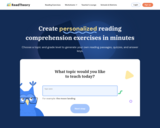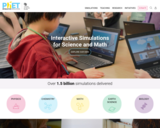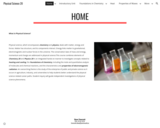
This clickable periodic table give facts about each of the elements. Also, learn the history of the periodic table.
- Subject:
- Chemistry
- Science
- Material Type:
- Activity/Lab
- Homework/Assignment
- Author:
- Doug Stewart
- Date Added:
- 03/26/2020

This clickable periodic table give facts about each of the elements. Also, learn the history of the periodic table.

Students explore their peripheral vision by reading large letters on index cards. Then they repeat the experiment while looking through camera lenses, first a lens with a smaller focal length and then a lens with a larger focal length. Then they complete a worksheet and explain how the experiment helps them solve the challenge question introduced in lesson 1 of this unit.

This is an activity about the basic properties of magnets and magnetism. Learners explore concepts such as magnetic fields and polarity, which form the basic ingredients of a study of Earth's magnetic field and the technology of magnetometers. Materials needed include bar magnets and paper clips. This is Activity 1 of Exploring Magnetism: A Teacher's Magnetism Activity Guide.

Students investigate how different riparian ground covers, such as grass or pavement, affect river flooding. They learn about permeable and impermeable materials through the measurement how much water is absorbed by several different household materials in a model river. Students use what they learn to make recommendations for engineers developing permeable pavement. Also, they consider several different limitations for design in the context of a small community.

Today we're going to talk about the birth of personal computing. Up until the early 1970s components were just too expensive, or underpowered, for making a useful computer for an individual, but this would begin to change with the introduction of the Altair 8800 in 1975. In the years that follow, we'll see the founding of Microsoft and Apple and the creation of the 1977 Trinity: The Apple II, Tandy TRS-80, and Commodore PET 2001. These new consumer oriented computers would become a huge hit, but arguably the biggest success of the era came with the release of the IBM PC in 1981. IBM completely changed the industry as its "IBM compatible" open architecture consolidated most of the industry except for, notably, Apple. Apple chose a closed architecture forming the basis of the Mac Vs PC debate that rages today. But in 1984, when Apple was losing marketshare fast it looked for a way to offer a new user experience like none other - which we'll discuss next week.

"Teachers can now create a custom passage, on any topic, with (5) corresponding questions and answer keys (of course).
This will allow you to align your lessons closely to the curriculum, build literacy across subject areas, and save time!
Although technology is remarkable, it takes the wisdom of an educator like you to truly breathe life into lessons. So be sure to add your human touch!"
EAL / ESL, Adult, special education options are also available

How can we convince others to agree with us on important issues? In this lesson, students explore relevant environmental issues and gather information to write persuasive essays.

Free online physics, chemistry, biology, earth science and math simulations.

PhET Sims are now available in HTML5 as well!
Simulations can be sorted by subject area or grade. This is very helpful.
PhET is a collection of interactive computer simulations for teaching and learning physics, chemistry, math, and other sciences.
Simulations can be used directly on the site or downloaded and used that way.
The simulations are animated, interactive, and game-like environments where students learn through exploration. They emphasize the connections between real-life and the underlying science. These great activities help students visualize abstract concepts!

Over 150 simulations, ready to use and ready to bring concepts to life for your students in Math & Science!

Through this lesson and its associated activity, students explore the role of biomedical engineers working for pharmaceutical companies. First, students gain background knowledge about what biomedical engineers do, how to become a biomedical engineer, and the steps of the engineering design process. The goal is to introduce biomedical engineering as medical problem solving as well as highlight the importance of maintaining normal body chemistry. Students participate in the research phase of the design process as it relates to improving the design of a new prescription medication. During the research phase, engineers learn about topics by reading scholarly articles written by others, and students experience this process. Students draw on their research findings to participate in discussion and draw conclusions about the impact of medications on the human body.

This site offers teacher resources in the areas of language arts, science, social studies and math, all in a wide variety of topics. Complete lesson plans included.

See how light knocks electrons off a metal target, and recreate the experiment that spawned the field of quantum mechanics.

Hank explains the extremely complex series of reactions whereby plants feed themselves on sunlight, carbon dioxide and water, and also create some by products we're pretty fond of as well.

This item addresses concepts such as: entropy, free energy, first law of thermodynamics, basic reaction kinetics.

Students download the software needed to create Arduino programs and make sure their Arduino microcontrollers work correctly. Then, they connect an LED to the Arduino and type up and upload programs to the Arduino board to 1) make the LED blink on and off and 2) make the LED fade (brighten and then dim). Throughout, students reflect on what they've accomplished by answering questions and modifying the original programs and circuits in order to achieve new outcomes. A design challenge gives students a chance to demonstrate their understanding of actuators and Arduinos; they design a functioning system using an Arduino, at least three actuators and either a buzzer or toy motor. For their designs, students sketch, create and turn in a user's manual for the system (text description, commented program, detailed hardware diagram). Numerous worksheets and handouts are provided.

Physical Geology is a comprehensive introductory text on the physical aspects of geology, including rocks and minerals, plate tectonics, earthquakes, volcanoes, mass wasting, climate change, planetary geology and much more. It has a strong emphasis on examples from western Canada. It is adapted from "Physical Geology" written by Steven Earle for the BCcampus Open Textbook Program. To access links to download PDF files, click the Read Book button below.

Most books that use MATLAB are aimed at readers who know how to program. This book is for people who have never programmed before. As a result, the order of presentation is unusual. The book starts with scalar values and works up to vectors and matrices very gradually. This approach is good for beginning programmers, because it is hard to understand composite objects until you understand basic programming semantics.

"Physical science, which encompasses chemistry and physics, deals with matter, energy and forces. Matter has structure, and its components interact. Energy links matter to gravitational, electromagnetic and nuclear forces in the universe. The conservation laws of mass and energy, momentum and charge are addressed in physical science.
This course combines elements of Chemistry 20 and Physics 20 in an integrated hands-on manner to investigate concepts related to heating and cooling, the foundations of chemistry, including the mole and quantitative analysis of molecules and chemical reactions, and the characteristics and properties of electromagnetic radiation. An overarching theme is the study of the enterprise of public and private science as it occurs in agriculture, industry, and universities to help students better understand the physical science related career paths. Student inquiry will guide independent investigations of physical science phenomena."

This teacher’s google site has lesson notes, videos, and worksheets with keys. I believe the teacher is Shana van den Heuvel based on who uploaded the files.